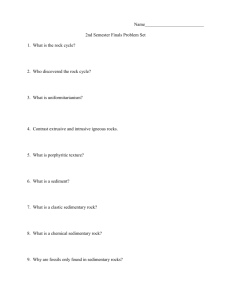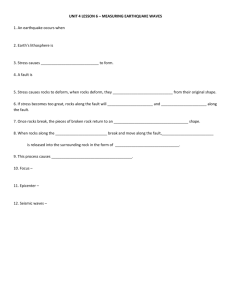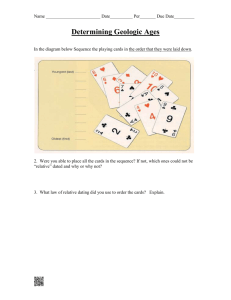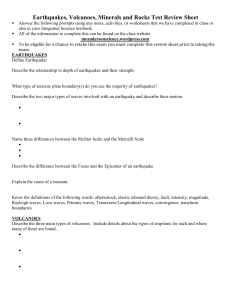Geol 101: Physical Geology
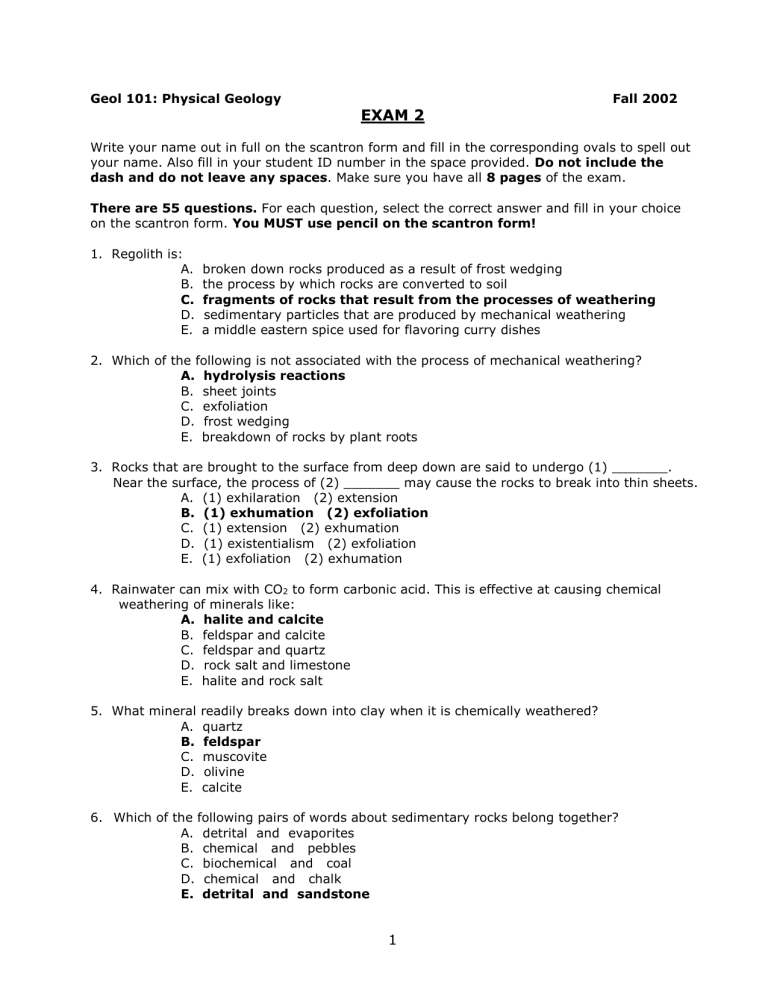
Geol 101: Physical Geology Fall 2002
EXAM 2
Write your name out in full on the scantron form and fill in the corresponding ovals to spell out your name. Also fill in your student ID number in the space provided. Do not include the
dash and do not leave any spaces. Make sure you have all 8 pages of the exam.
There are 55 questions. For each question, select the correct answer and fill in your choice on the scantron form. You MUST use pencil on the scantron form!
1. Regolith is:
A. broken down rocks produced as a result of frost wedging
B. the process by which rocks are converted to soil
C. fragments of rocks that result from the processes of weathering
D. sedimentary particles that are produced by mechanical weathering
E. a middle eastern spice used for flavoring curry dishes
2. Which of the following is not associated with the process of mechanical weathering?
A. hydrolysis reactions
B. sheet joints
C. exfoliation
D. frost wedging
E. breakdown of rocks by plant roots
3. Rocks that are brought to the surface from deep down are said to undergo (1) _______.
Near the surface, the process of (2) _______ may cause the rocks to break into thin sheets.
A. (1) exhilaration (2) extension
B. (1) exhumation (2) exfoliation
C. (1) extension (2) exhumation
D. (1) existentialism (2) exfoliation
E. (1) exfoliation (2) exhumation
4. Rainwater can mix with CO
2
to form carbonic acid. This is effective at causing chemical weathering of minerals like:
A. halite and calcite
B. feldspar and calcite
C. feldspar and quartz
D. rock salt and limestone
E. halite and rock salt
5. What mineral readily breaks down into clay when it is chemically weathered?
A. quartz
B. feldspar
C. muscovite
D. olivine
E. calcite
6.
Which of the following pairs of words about sedimentary rocks belong together?
A. detrital and evaporites
B. chemical and pebbles
C. biochemical and coal
D. chemical and chalk
E. detrital and sandstone
1
7. Detrital sedimentary rocks contain small particles of sediment called (1) ______. If these particles are broken down pieces of rocks, they are called (2) _______.
A. (1) detritus (2) pebbles
B. (1) detritus (2) grains
C. (1) clasts (2) detritus
D. (1) clasts (2) lithic fragments
E. (1) regolith (2) clastic fragments
8. The remains of sea organisms with shells made of silica accumulate on ocean bottoms as biogenic sediment that eventually forms a type of rock called:
A. rock salt
B. limestone
C. chert
D. phosphorites
E. peat
9. Which of the following statements about sedimentary rocks is TRUE?
A. sedimentary rocks only make up about 5% of the crust
B. sedimentary rocks are the type of rock we see most often at the Earth’s surface
C. diagenesis during burial turns loose sediment into sedimentary rock
D. the process of turning loose sediment into rock is also called lithification
E. all of the above
10. Which of the following sedimentary structures is common in sand dunes?
A. ripple marks
B. cross-bedding
C. graded bedding
D. mudcracks
E. all of the above
11. A very short time break or a change in sediment type in a depositional environment results in the creation of (1) ______. A very long time break produces (2) ________.
A. (1) a bedding plane (2) an unconformity
B. (1) a bedding plane (2) a graded bed
C. (1) an unconformity (2) a graded bed
D. (1) an unconformity (2) a bedding plane
E. (1) a graded bed (2) an intrusive contact
12. Cross-bedding is useful to geologists because:
A. it can be used to determine paleocurrent directions
B. it always indicates whether the bed formed by water or by wind currents
C. it allows regular bedding to be more easily distinguished
D. it indicates whether a current flowed in one direction only or back and forth
E. it makes rocks much more interesting to look at
13. Which of the following is NOT a type of trace fossil?
A. worm trails
B. burrows
C. animal footprints
D. shells
E. all of the above are trace fossils
2
14. Which of the following statements about metamorphism is FALSE?
A. metamorphic rocks form from older sedimentary, igneous, or metamorphic rocks
B. metamorphic means “change of form”
C. during metamorphism, existing minerals are transformed into new minerals
D. diagenesis must happen during burial before metamorphism begins
E. metamorphism involves melting of existing rocks to form new minerals
15. A foliation develops in a metamorphic rock because:
A. platy minerals always align with each other during metamorphism
B. the rock that got metamorphosed also had a foliation in it
C. differential stress causes minerals to align parallel to each other
D. high temperatures cause minerals to recrystallize with a foliation
E. this is what metamorphic rocks are all about
16. An aureole is associated with the following type of metamorphism:
A. regional metamorphism
B. burial metamorphism
C. dynamic metamorphism
D. contact metamorphism
E. hydrothermal metamorphism
17. What is meant by the phrase chronological sequence?
A. it refers to the absolute ages of rocks
B. it is one of the principles of stratigraphy used to determine relative ages
C. it is the order that things happened in geologic history
D. it is the geologic time scale used to determine the ages of all rocks
E. it is the amount of time that a radioactive substance takes to decay
18. In stratigraphy, the principle of stratigraphic superposition states that:
A. all sedimentary layers start off being horizontal
B. the relative ages of all sedimentary layers can be determined using fossils
C. any sedimentary layer is older than the layer above it and younger than
the layer below it
D. any sedimentary layer is younger than the layer above it and older than the layer below it
E. a sedimentary layer must be older than any feature that cuts through it or disrupts it
19. When initially flat-lying beds get tilted and eroded, then new flat-lying beds get deposited on top, the type of unconformity that results is called a/an:
A. cross-bed
B. nonconformity
C. intrusive contact
D. disconformity
E. angular unconformity
20. The technique of using fossil assemblages to determine that two rock units in different locations formed during the same period of geologic time is called:
A. evolution
B. correlation
C. bioanalysis
D. paleontology
E. stratigraphy
3
21. A sedimentary bed contains three fossils: A, B, and C. Fossil A is known to have existed in the
Cambrian and Ordovician Periods only. Fossil B existed in the Ordovician and Silurian Periods only. Fossil C existed for a very long time on Earth- during the Cambrian, Ordovician, Silurian,
Devonian, and Carboniferous Periods. Based on this fossil assemblage, what must the age of the rock be?
A. Cambrian
B. Ordovician
C. Silurian
D. sometime between the Cambrian and the Carboniferous is all that we can tell
E. it’s impossible to tell
22. What happened on Earth 66 million years ago?
A. the Cenozoic Era began
B. the Tertiary Period began
C. the Paleocene Epoch began
D. dinosaurs went extinct on the Earth
E. all of the above
23. The epoch that we currently live in is called the:
A. Holocene
B. Pleistocene
C. Pliocene
D. Miocene
E. Paleocene
24. The Hadean, Archean, and Proterozoic eons are collectively called the:
A. Phanerozoic
B. Mesozoic
C. Holocene
D. Precambrian
E. days of yore
25. The process of alpha decay is when:
A. an atom releases a pair of protons and a pair of neutrons from the nucleus
B. an atom releases a proton and a neutron from the nucleus
C. an atom releases an electron from the nucleus as a neutron turns into a proton
D. an atom releases a pair of protons and a pair of electrons from the nucleus
E. an atom turns all its protons into neutrons and calls itself Switzerland
26. An isotope that undergoes decay starts off as a (1) _____ and becomes a (2) _____:
A. (1) alpha particle (2) beta particle
B. (1) daughter (2) son
C. (1) daughter (2) parent
D. (1) parent (2) daughter
E. (1) parent (2) mutant
27. Which of the following statements about radioactive decay is TRUE?:
A. decay rates are affected by the physical and chemical environment
B. alpha decay is always followed by beta decay
C. the amount of daughter isotopes is always decreasing
D. one half of the available unstable isotopes always decays during one half-life
E. all daughter isotopes are stable
4
28. Elastic deformation in a rock indicates that:
A. the strength of the rock has been overcome
B. the rock has undergone fracturing
C. the rock is behaving in a plastic manner, like salt water taffy
D. the rock can release stored energy and return to its original shape
E. the rock will eventually cause an earthquake
29. Which part of the Earth is most prone to brittle deformation?
A. crust
B. mantle
C. outer core
D. inner core
E. all of the above
30. The speed that deformation occurs inside rocks is:
A. without exception, extremely slow
B. about 3 cm per year
C. called the strain rate
D. fast enough to observe on a day-to-day basis
E. very rapid for the case of ductile deformation
31. An example of high strain rate deformation is:
A. folding
B. elastic deformation
C. plastic flow
D. bending
E. earthquakes
32.
The tensional stress that formed a joint…
A. was oriented parallel to the orientation of the joint
B. was oriented perpendicular to the orientation of the joint
C. was oriented obliquely to the orientation of the joint
D. cannot be determined from the joint orientation
E. joints don’t form because of tensional stresses
33. If a fault plane is dipping, the block of rock above the fault plane is the (1) _______ and the block below the fault plane is the (2) __________.
A. (1) footwall (2) hanging wall
B. (1) footwall (2) fault scarp
C. (1) fault scarp (2) footwall
D. (1) hanging wall (2) fault scarp
E. (1) hanging wall (2) footwall
34. Along any fault, the (1) ________ moves up and the (2) ________ moves down:
A. (1) hanging wall (2) footwall
B. (1) footwall (2) hanging wall
C. (1) fault block (2) fault plane
D. (1) fault plane (2) hanging wall
E. more information about the fault is needed to answer this question
5
35. Which of the following types of faults is unlikely to have either a footwall or a hanging wall?
A. normal
B. reverse
C. strike-slip
D. oblique-slip
E. thrust
36. Along the San Andreas fault, the east side is moving towards the south and the west side is moving towards the north. This makes the San Andreas fault a _______:
A. normal fault
B. left-lateral fault
C. right-lateral fault
D. reverse fault
E. graben fault
37. Rocks that warp upwards in the center of a fold produce a type of fold called a/an (1) _______ whereas rocks that warp downwards in the center produce a/an (2) ________.
A. (1) syncline (2) monocline
B. (1) syncline (2) anticline
C. (1) anticline (2) syncline
D. (1) anticline (2) monocline
E. (1) anti-plunging fold (2) plunging fold
38. Which of the following statements about anticlines is FALSE?
A. all anticlines have two fold limbs
B. an anticline must have a syncline next to it
C. plunging anticlines produce a zig-zagging patterns of rocks at the surface
D. at the surface, the youngest aged rocks are at the center of an anticline
E. anticlines are evidence of ductile deformation of rocks
39. Which of the following is not a major influence on the cause of earthquakes?
A. ductile deformation
B. elastic energy buildup in rocks
C. friction
D. tectonic stresses
E. faults
40. The process of creep along faults is when:
A. faults produce earthquakes constantly because they never stop sliding
B. faults have low amounts of friction along them so they slide all the time
C. slow-slipping faults start to slip faster and faster until an earthquake occurs
D. faults start to behave in a ductile manner
E. there is not enough tectonic stress available to produce an earthquake
41. The largest earthquake ever felt in the continental United States during historical times was:
A. in New Madrid, Missouri during the winter of 1811-1812
B. in San Francisco in 1906
C. in southern Alaska in 1964
D. in Charleston, South Carolina in 1886
E. off the coast of Chile in 1960
6
42. The second largest earthquake ever recorded on Earth happened:
A. in New Madrid, Missouri during the winter of 1811-1812
B. in San Francisco in 1906
C. in southern Alaska in 1964
D. in Charleston, South Carolina in 1886
E. off the coast of Chile in 1960
43. Seismic waves are recorded by an instrument called a (1) _________ and the record of the earthquake that the instrument generates is called a (2) _________.
A. (1) seismograph (2) seismometer
B. (1) seismograph (2) seismogram
C. (1) seismometer (2) seismograph
D. (1) seismogram (2) seismograph
E. (1) seismogram (2) seismometer
44. The focus of an earthquake is:
A. the location along the fault where the earthquake rupture starts
B. the point on the Earth’s surface where surface waves are created
C. the point on the Earth's surface directly above where the rupture starts
D. exactly the same as the epicenter of an earthquake
E. sometimes as deep as 1000 km
45. Which of the following types of waves is unable to pass through a liquid?
A. P-waves
B. sound waves
C. water waves
D. primary waves
E. S-waves
46. How many seismograph stations are required to determine the location of an earthquake epicenter?
A. 1
B. 2
C. 3
D. 4
E. 5
47. The earthquake scale that measures energy release by considering the physical characteristics of motion along the fault, such as amount of fault slip and the size of the fault that ruptured, is called the:
A. Richter scale
B. moment magnitude scale
C. intensity scale
D. modified Mercalli scale
E. ground acceleration scale
48. The intensity of the 2001 Nisqually earthquake (M6.8) near Seattle was far less than that of the 1994 Northridge earthquake (M6.7) near Los Angeles because:
A. Seattle is not as heavily populated as Los Angeles
B. a mistake was made in calculating the magnitude of the Northridge earthquake
C. buildings in Seattle are designed better than those in Los Angeles
D. the focus of the Nisqually earthquake was much deeper than at Northridge
E. Seattle is closer to the water, which absorbed a lot of the seismic waves
7
49. Which of the following seismic hazards would not be associated with earthquakes that occur in the New Madrid seismic zone in Missouri?
A. ground shaking
B. liquefaction
C. fire
D. ground fractures
E. tsunamis
50. Which of the following is an accurate description of liquefaction?
A. when ground shaking causes water-saturated sediment to act like quicksand
B. when a shift of the ocean bottom produces a giant wave at the surface
C. when earthquakes cause waterlogged mountain slopes to produce landslides
D. when seismic waves get amplified in loose sediments, causing more shaking
E. when water erupts at the surface during an earthquake, creating a ground fissure
BONUS QUESTIONS
51. Open All Eyes Before Class. Which of the following words fits the theme of this acronym?
A. regolith
B. sandstone
C. foliation
D. humus
E. Cenozoic
52. Cambrian, Ordovician, Silurian, Devonian, Carboniferous. What comes next?
A. Triassic
B. Tertiary
C. Quaternary
D. Permian
E. Jurassic
53. The slowest of all the types of seismic waves are the:
A. Love waves
B. S-waves
C. Rayleigh waves
D. P-waves
E. body waves
54. The 1964 Good Friday earthquake in Alaska resulted in 159 deaths in which state?
A. British Columbia
B. California
C. Oregon
D. Hawai’i
E. Missouri
55. Which of the following locations is NOT at risk from a continental interior earthquake?
A. Seattle, WA
B.
Charleston, SC
C.
Memphis, TN
D.
Salt Lake City, UT
E.
Borah Peak, ID
8

